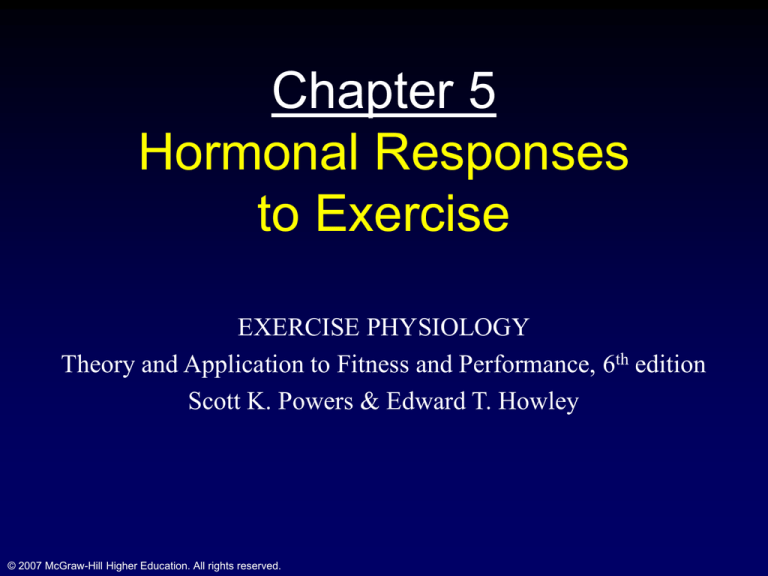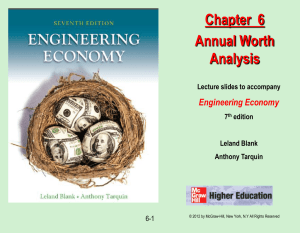
Chapter 5
Hormonal Responses
to Exercise
EXERCISE PHYSIOLOGY
Theory and Application to Fitness and Performance, 6th edition
Scott K. Powers & Edward T. Howley
© 2007 McGraw-Hill Higher Education. All rights reserved.
Objectives
• Describe the hormone-receptor interaction
• Identify four factors that influence the
contraction of a hormone in the blood
• Describe how steroid hormones act on cells
• Describe “second messenger” hormone action
• Describe the role of hypothalamus-releasing
factors in the control of hormone secretion
from the anterior and posterior pituitary
© 2007 McGraw-Hill Higher Education. All rights reserved.
Objectives
• Identify the site of release, stimulus for
release, and the predominate action of the
following hormones: epinephrine,
norepinephrine, glucagon, insulin, cortisol,
aldosterone, thyroxine, growth hormone,
estrogen, and testosterone
• Discuss the use of anabolic steroid and growth
hormone on muscle growth and their potential
side effects
© 2007 McGraw-Hill Higher Education. All rights reserved.
Objectives
• Contrast the role of plasma catecholamines
with intracellular factors in the mobilization of
muscle glycogen during exercise
• Graphically describe the changes in the
following hormones during graded and
prolonged exercise and discuss how those
changes influence the four mechanisms used
to maintain the blood glucose concentration:
insulin, glucagon, cortisol, growth hormone,
epinephrine, and norepinephrine
© 2007 McGraw-Hill Higher Education. All rights reserved.
Objectives
• Describe the effect of changing hormone and
substrate levels in the blood on the
mobilization of free fatty acids from adipose
tissue
© 2007 McGraw-Hill Higher Education. All rights reserved.
Neuroendocrinology
• Endocrine glands release hormones directly into
the blood
• Hormones alter the activity of tissues that
possess receptors to which the hormone can
bind
• The plasma hormone concentration determines
the magnitude of the effect at the tissue level
© 2007 McGraw-Hill Higher Education. All rights reserved.
Blood Hormone Concentration
Determined by:
• Rate of secretion of hormone from endocrine
gland
• Rate of metabolism or excretion of hormone
• Quantity of transport protein
• Changes in plasma volume
© 2007 McGraw-Hill Higher Education. All rights reserved.
Control of Hormone Secretion
• Rate of insulin secretion from the pancreas is
dependent on:
– Magnitude of input
– Stimulatory vs. inhibitory
© 2007 McGraw-Hill Higher Education. All rights reserved.
Factors That Influence the
Secretion of Hormones
Fig 5.1
© 2007 McGraw-Hill Higher Education. All rights reserved.
Hormone-Receptor
Interactions
• Trigger events at the cell
• Magnitude of effect dependent on:
– Concentration of the hormone
– Number of receptors on the cell
– Affinity of the receptor for the hormone
© 2007 McGraw-Hill Higher Education. All rights reserved.
Hormone-Receptor
Interactions
• Hormones bring about effects by:
– Altering membrane transport
– Stimulating DNA to increase protein
synthesis
– Activating second messengers
• Cyclic AMP
• Ca++
• Inositol triphosphate
• Diacylglycerol
© 2007 McGraw-Hill Higher Education. All rights reserved.
Mechanism of
Steroid
Hormones
Fig 5.2
© 2007 McGraw-Hill Higher Education. All rights reserved.
Cyclic AMP
“Second
Messenger”
Mechanism
Fig 5.3
© 2007 McGraw-Hill Higher Education. All rights reserved.
Other
“Second
Messenger”
Systems
Fig 5.4
© 2007 McGraw-Hill Higher Education. All rights reserved.
Hormones:
Regulation and Action
• Hormones are secreted from endocrine
glands
– Hypothalamus and pituitary glands
– Thyroid and parathyroid glands
– Adrenal glands
– Pancreas
– Testes and ovaries
© 2007 McGraw-Hill Higher Education. All rights reserved.
Hypothalamus
• Controls activity of the anterior and posterior
pituitary glands
• Influenced by positive and negative input
© 2007 McGraw-Hill Higher Education. All rights reserved.
Positive and
Negative Input
to the
Hypothalamus
Fig 5.6
© 2007 McGraw-Hill Higher Education. All rights reserved.
Anterior Pituitary Gland
Fig 5.5
© 2007 McGraw-Hill Higher Education. All rights reserved.
Growth Hormone
• Secreted from the anterior pituitary gland
• Essential for normal growth
– Stimulates protein synthesis and long bone
growth
• Increases during exercise
– Mobilizes fatty acids from adipose tissue
– Aids in the maintenance of blood glucose
© 2007 McGraw-Hill Higher Education. All rights reserved.
Growth
Hormone
Fig 5.6
© 2007 McGraw-Hill Higher Education. All rights reserved.
Posterior Pituitary Gland
• Secretes antidiuretic hormone (ADH) or
vasopressin
• Reduces water loss from the body to
maintain plasma volume
• Stimulated by:
– High plasma osmolality and low
plasma volume due to sweating
– Exercise
© 2007 McGraw-Hill Higher Education. All rights reserved.
Change in the Plasma ADH
Concentration During Exercise
Fig 5.7
© 2007 McGraw-Hill Higher Education. All rights reserved.
Thyroid Gland
• Triiodothyronine (T3) and thyroxine (T4)
– Important in maintaining metabolic
rate and allowing full effect of other
hormones
• Calcitonin
– Regulation of plasma Ca++
• Parathyroid Hormone
– Also involved in plasma Ca++
regulation
© 2007 McGraw-Hill Higher Education. All rights reserved.
Adrenal Medulla
• Secretes Epinephrine and
Norepinephrine
• Increases
–HR, glycogenolysis, lypolysis,
© 2007 McGraw-Hill Higher Education. All rights reserved.
Adrenal Cortex
• Mineralcorticoids (aldosterone)
– Maintain plasma Na+ and K+
– Regulation of blood pressure
© 2007 McGraw-Hill Higher Education. All rights reserved.
Change in Mineralcorticoids
During Exercise
Fig 5.8
© 2007 McGraw-Hill Higher Education. All rights reserved.
Adrenal Cortex
• Glucocorticoids (Cortisol)
– Stimulated by exercise and long-term
fasting
– Promotes the use of free fatty acids
as fuel
– Stimulates glucose synthesis
– Promotes protein breakdown for
gluconeogenesis and tissue repair
© 2007 McGraw-Hill Higher Education. All rights reserved.
Control of
Cortisol
Secretion
Fig 5.9
© 2007 McGraw-Hill Higher Education. All rights reserved.
Pancreas
• Secretes digestive enzymes and bicarbonate
into small intestine
• Releases
– Insulin - Promotes the storage of glucose,
amino acids, and fats
– Glucagon - Promotes the mobilization of
fatty acids and glucose
– Somatostatin - Controls rate of entry of
nutrients into the circulation
© 2007 McGraw-Hill Higher Education. All rights reserved.
Testes
• Release testosterone
– Anabolic steroid
• Promotes tissue (muscle) building
• Performance enhancement
– Androgenic steroid
• Promotes masculine characteristics
© 2007 McGraw-Hill Higher Education. All rights reserved.
Control of
Testosterone
Secretion
Fig 5.10
© 2007 McGraw-Hill Higher Education. All rights reserved.
Estrogen
• Establish and maintain reproductive
function
• Levels vary throughout the menstrual
cycle
© 2007 McGraw-Hill Higher Education. All rights reserved.
Control of
Estrogen
Secretion
Fig 5.11
© 2007 McGraw-Hill Higher Education. All rights reserved.
Muscle Glycogen Utilization
• Breakdown of muscle glycogen is under dual
control
– Epinephrine-cyclic AMP
– Ca2+-calmodulin
• Delivery of glucose parallels activation of
muscle contraction
• Glycogenolysis – breakdown of glycogen
Fig 5.16
© 2007 McGraw-Hill Higher Education. All rights reserved.
Control of Glycogenolysis
Glycogenolysis
Fig 5.16
© 2007 McGraw-Hill Higher Education. All rights reserved.
Muscle Glycogen Utilization
• Glycogenolysis is related to exercise intensity
– High-intensity of exercise results in greater
and more rapid glycogen depletion Fig 5.13
• Plasma epinephrine is a powerful simulator of
glycogenolysis
– High-intensity of exercise results in greater
increases in plasma epinephrine
Fig 5.14
© 2007 McGraw-Hill Higher Education. All rights reserved.
Glycogen Depletion During
Exercise
Fig 5.13
© 2007 McGraw-Hill Higher Education. All rights reserved.
Plasma Epinephrine
Concentration During Exercise
Fig 5.14
© 2007 McGraw-Hill Higher Education. All rights reserved.
Maintenance of Plasma
Glucose During Exercise
• Mobilization of glucose from liver glycogen
stores
• Mobilization of FFA from adipose tissue
– Spares blood glucose
• Gluconeogenesis from amino acids, lactic
acid, and glycerol
• Blocking the entry of glucose into cells
– Forces use of FFA as a fuel
© 2007 McGraw-Hill Higher Education. All rights reserved.
Blood Glucose Homeostasis
During Exercise
• Permissive and slow-acting hormones
– Thyroxine
– Cortisol
– Growth hormone
• Act in a permissive manner to support
actions of other hormones
© 2007 McGraw-Hill Higher Education. All rights reserved.
Cortisol
• Stimulates FFA mobilization from
adipose tissue
• Mobilizes amino acids for
gluconeogenesis
• Blocks entry of glucose into cells
Fig 5.17
© 2007 McGraw-Hill Higher Education. All rights reserved.
Role of Cortisol in the
Maintenance of Blood
Glucose
Fig 5.17
© 2007 McGraw-Hill Higher Education. All rights reserved.
Plasma Cortisol During
Exercise
• At low intensity
– plasma cortisol decreases
• At high intensity
– plasma cortisol increases
Fig 5.18
© 2007 McGraw-Hill Higher Education. All rights reserved.
Changes in Plasma Cortisol
During Exercise
Fig 5.18
© 2007 McGraw-Hill Higher Education. All rights reserved.
Growth Hormone
• Important in the maintenance of plasma
glucose
– Decreases glucose uptake
– Increases FFA mobilization
– Enhances gluconeogenesis
Fig 5.19
© 2007 McGraw-Hill Higher Education. All rights reserved.
Growth Hormone in the
Maintenance of Plasma Glucose
Fig 5.19
© 2007 McGraw-Hill Higher Education. All rights reserved.
Growth Hormone During Exercise:
Effect of Intensity
Fig 5.20
© 2007 McGraw-Hill Higher Education. All rights reserved.
Growth Hormone During Exercise:
Trained vs. Untrained
Fig 5.20
© 2007 McGraw-Hill Higher Education. All rights reserved.
Blood Glucose Homeostasis
During Exercise
• Fast-acting hormones
– Norepinephrine and epinephrine
– Insulin and glucagon
• Maintain plasma glucose
– Increasing liver glucose mobilization
– Increased levels of plasma FFA
– Decreasing glucose uptake
– Increasing gluconeogenesis
Fig 5.21
© 2007 McGraw-Hill Higher Education. All rights reserved.
Role of Catecholamines in
Substrate Mobilization
Fig 5.21
© 2007 McGraw-Hill Higher Education. All rights reserved.
Epinephrine & Norepinephrine
During Exercise
• Increase linearly during exercise
• Favor the mobilization of FFA and
maintenance of plasma glucose
© 2007 McGraw-Hill Higher Education. All rights reserved.
Change in Plasma Catecholamines
During Exercise
Fig 5.22
© 2007 McGraw-Hill Higher Education. All rights reserved.
Epinephrine & Norepinephrine
Following Training
• Decreased plasma levels in response to
exercise bout
• Parallels reduction in glucose mobilization
© 2007 McGraw-Hill Higher Education. All rights reserved.
Plasma Catecholamines
During Exercise Following
Training
Fig 5.23
© 2007 McGraw-Hill Higher Education. All rights reserved.
Effects of Insulin & Glucagon
Fig 5.24
© 2007 McGraw-Hill Higher Education. All rights reserved.
Insulin During Exercise
• Plasma insulin decreases during exercise
– Prevents rapid uptake of plasma glucose
– Favors mobilization of liver glucose and
lipid FFA
• Trained subjects during exercise
– More rapid decrease in plasma insulin
– Increase in plasma glucagon
© 2007 McGraw-Hill Higher Education. All rights reserved.
Changes in Plasma Insulin
During Exercise
Fig 5.25
© 2007 McGraw-Hill Higher Education. All rights reserved.
Effect of Training on Plasma
Insulin During Exercise
Fig 5.25
© 2007 McGraw-Hill Higher Education. All rights reserved.
Effect of Training on Plasma
Glucagon During Exercise
Fig 5.26
© 2007 McGraw-Hill Higher Education. All rights reserved.
Effect of SNS on Substrate
Mobilization
Fig 5.28
© 2007 McGraw-Hill Higher Education. All rights reserved.
Hormonal Responses to
Exercise
Fig 5.29a
© 2007 McGraw-Hill Higher Education. All rights reserved.
Hormonal Responses to
Exercise
Fig 5.29b
© 2007 McGraw-Hill Higher Education. All rights reserved.
Free Fatty Acid Mobilization
During Heavy Exercise
• FFA mobilization decreases during heavy
exercise
– This occurs in spite of persisting hormonal
stimulation for FFA mobilization
• May be due to high levels of lactic acid
– Promotes resynthesis of triglycerides
– Inadequate blood flow to adipose tissue
– Insufficient transporter for FFA in plasma
© 2007 McGraw-Hill Higher Education. All rights reserved.
Effect of Lactic Acid on FFA
Mobilization
Fig 5.30
© 2007 McGraw-Hill Higher Education. All rights reserved.
Chapter 5
Hormonal Responses
to Exercise
© 2007 McGraw-Hill Higher Education. All rights reserved.









